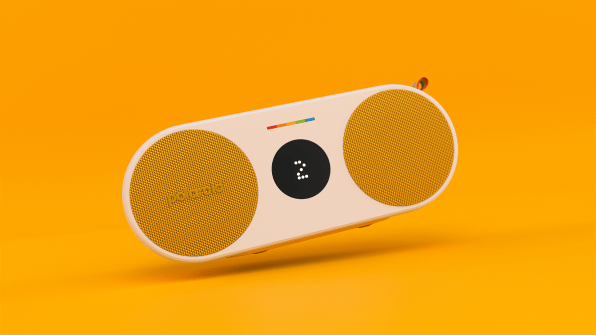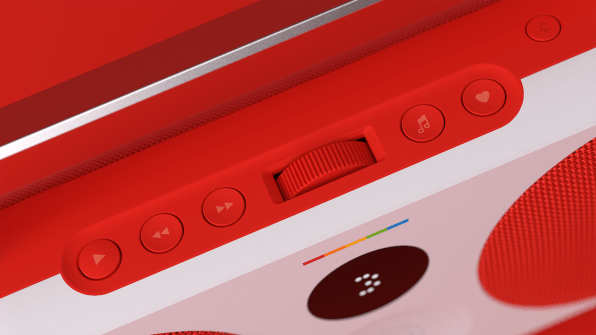Polaroid’s new jam is music
Even without their logos, you might be able to identify them as Polaroid products. They’re all emblazoned with the company’s “spectrum” stripe of rainbow colors and have white plastic cases and big red buttons linking them to other Polaroid devices all the way back to the 1970s.
It’s just that these Polaroid products don’t happen to be instant cameras. They’re Bluetooth speakers—the first result of a new initiative by the most famous name in instant photography to get people to think of it as a brand that’s about more than instant photography.
The lineup includes four Polaroid Players—the P1, P2, P3, and P4—ranging from an almost pocket-sized $60 version with a carabiner clip to a beefy $290 model with a boombox-like handle. All support Bluetooth streaming, work with a Polaroid Music smartphone app that has five stations of its own as well as Apple Music integration (Spotify is in the works), and can be used in pairs as wireless stereo systems.
It might not be intuitively obvious that the world needed Polaroid speakers, or that the company needed to make them. After all, instant photography—once left for dead in the wake of the digital revolution—is alive and well. Today’s Polaroid is actually a merger of the remnants of the original Polaroid and The Impossible Project, a startup that rescued Polaroid film from oblivion; it’s snapped back to life in ways that few would have predicted.
But Polaroid chairman Oskar Smolokowski says that the company’s symbiotic relationship with a single decades-old analog technology is also limiting: “It still inspires people and is magical, but it cannot be the only thing that we do if we want to give Polaroid a future.”

[Photo: Courtesy Polaroid]
If Polaroid was going to try something new, music had a certain logic. The company had long played with audio around the edges: Both the original Polaroid and The Impossible Project tried to figure out a way to associate a snippet of sound with an instant photo, though neither effort went anywhere. There was even a Polaroid transistor radio that was powered by the leftover battery juice in depleted film packs.
Still, the strongest argument for the expansion into music is that the Polaroid brand is already associated with creativity, fun times, and social connections, all of which helps explain why people love music. “This is a space that feels right for us,” says Smolokowski.
Brand-stretching, for good and bad
This will be far from the first time that Polaroid has branched out beyond instant photography—which, it’s easy to forget, was not even its original business. The company’s very name is a clue: It stems from founder Edwin Land’s breakthroughs in synthetic polarizers, which he achieved years before he turned his attention to photography. Polaroid polarized sunglasses predate the cameras and remain available, albeit made by a different Polaroid than the instant-camera one.
[pullquote]Like Polaroid’s current cameras, the speakers evoke its aesthetic without feeling stridently retro.[/pullquote]In recent decades, however, the broadening of the Polaroid brand has usually been a sign of trouble. In the 1980s, as instant photography started maxing out as a business, the company began selling 35mm film and blank videotapes. Later, after it discontinued production of instant cameras and film, it survived only as a zombie brand-for-rent, available for use on . . . well, seemingly anything, from TVs to smartphones to game controllers to yoga mats. And yes, there have been a number of previous Polaroid Bluetooth speakers.
Familiar names of yore will always have residual value, which is why you can buy everything from Westinghouse ceiling fans to Bell & Howell bug zappers. With its new Players, however, Polaroid is trying for something more thoughtful.
Like its current cameras, the speakers evoke the familiar Polaroid aesthetic while simultaneously feeling fresh rather than stridently retro. They’ve got dials that let you adjust volume and select favorites with a satisfying physicality that’s become rare in modern consumer electronics devices. All but the smallest have round LED displays that display unapologetically blocky text and icons.
There are even some Easter Eggs for Polaroid fans. The red play button is exactly the same size as the company’s camera shutter buttons, for example, and you can tote the speakers by attaching the same neck strap you’d use with a Polaroid camera.

[Photo: Courtesy Polaroid]
The Players’ exuberance is striking in an era when device design often seems happy enough to recede into the background. Most competitive products are “either black or muted colors,” says Smolokowski. “We just wanted to celebrate a little bit more—lively and bright—so colors are an important aspect of it as well.”
“This is something that is very Polaroid in a way,” says chief design officer Ignacio Germade. “The Polaroid camera is not something that disappears in the room. It has a certain presence. It’s something that you put in a room full of people, and suddenly it has an effect on the room. It has an effect on the people. And in designing the speakers, we wanted to do the same thing.”
Then there’s the smartphone app. With a total of five stations for now, it’s not going to be anyone’s sole source of music, but Polaroid sees it as a significant part of the package.
“We spent a lot of time thinking, ‘Okay, what is the kind of music that gives you the emotional response that you get when you look at the Polaroid picture?” explains Germade. That led the company to create human-curated stations, with names such as Polychrome (“Like a rave in a kaleidoscope”) and Royal Pine (“Uplifting anthems with real roots”), that aren’t strictly programmed by genre or decade. You might hear Santana and Rosalía on the same station, Germade says.
Between the new speakers and the app, the goal is to create an experience that might be a springboard for further exploration of music as a category, though Polaroid isn’t talking about where it could go. But just in case anyone wonders if its passion for its best-known business is flagging, think again.
“We are definitely still very serious about instant photography,” says Smolokowski, who adds that the company is working on “our first more capable camera, optically” for release next year.
After all, even if this Polaroid music thing takes off, it’s a safe bet that the brand will always bring one thing to mind first: pictures that develop before your eyes.
(52)


